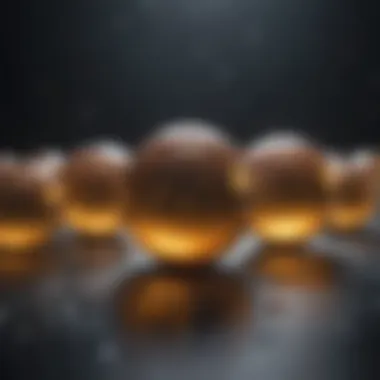Exploring the Science and Applications of Latex Spheres


Intro
Latex spheres, often seen as simple objects, possess complex characteristics and play significant roles across multiple scientific disciplines. These spheres originate from latex, a natural or synthetic polymer, which imparts unique properties that make them valuable in various applications. Understanding the multifaceted nature of latex spheres is crucial for recognizing their contributions to fields like biology, chemistry, and materials science.
This investigation will explore crucial elements such as the composition of latex spheres, their manufacturing processes, and the range of uses within scientific research and industry. By dissecting these components, we aim to highlight their importance in advancing knowledge and technology. Furthermore, we will examine how contemporary research informs our understanding of these versatile materials, ultimately enriching the discourse surrounding their applications.
Preface to Latex Spheres
Latex spheres have gained significant attention in scientific research and industry due to their versatility and unique properties. Understanding the intricate aspects of latex spheres is essential for multiple fields, as they play crucial roles in various applications. Their importance flows from not just their structural characteristics, but also their broad range of uses which span from medical applications to chemical analysis and even materials science.
The study of latex spheres encompasses their chemical composition, manufacturing processes, and resulting properties. By delving into these areas, this article aims to shed light on both the functionality and relevance of latex spheres in today’s technological environment. It is vital to grasp how these tiny objects can have such a profound effect on scientific advancements.
Definition and Overview
Latex spheres are spherical particles made from latex materials, commonly formed through processes such as emulsion polymerization. They are usually comprised of polymers, which are complex structures made from repeating units of monomers. Latex spheres can vary widely in size, typically ranging from a few nanometers to several micrometers. The degree of elasticity, stability, and surface characteristics can be fine-tuned during their production, allowing for diverse applications.
In many instances, latex spheres are employed as carriers or markers in biological assays, providing pivotal information concerning the samples they interact with. Their surface can be modified with various functional groups, making them highly adaptable for specific tasks in different environments. This customization enhances their performance in targeted uses.
Historical Development
The evolution of latex spheres parallels advances in chemistry and material science throughout the 20th century. The first synthetic latex was developed in the early 1900s, leading to the production of a wide array of polymer-based materials, which eventually included latex spheres. Early applications focused on consumer products, such as rubber balls and adhesives.
However, the advent of more sophisticated techniques, especially in polymerization processes during the mid-20th century, opened new avenues for latex sphere technology. Researchers began exploring their potential in therapeutic and diagnostic fields. For example, in immunology, latex spheres have been used in agglutination tests, allowing for the qualitative analysis of various samples. This historical context is crucial for understanding the current advancements and potential future directions in the use of latex spheres.
Through this historical lens, it becomes evident how innovation and inquiry into latex spheres have produced significant contributions across multiple disciplines. They have evolved from simple consumer goods to advanced materials with specialized functions, affirming their importance in both practice and research.
Chemical Composition of Latex Spheres
The chemical composition of latex spheres is crucial for understanding their properties and applications. A deep dive into this topic reveals key information about the materials that form the basis of these spheres. This knowledge empowers researchers and professionals to optimize the usage of latex spheres in various scientific fields.
Polymers in Latex Spheres
Polymers are significant components in the formation of latex spheres. They are long-chain molecules that give latex its unique characteristics. Usually, the primary polymer used in latex spheres is polybutadiene or styrene-butadiene copolymers. These choices are not arbitrary; they directly influence the flexibility, durability, and chemical resistance of the spheres.
The synthesis process, specifically emulsion polymerization, allows the formation of small latex particles dispersed in water. The size of these particles can range from 50 to 500 nanometers, which is an important factor affecting their behavior in different applications. Researchers focus on carefully selecting the type and mixture of polymers to create latex spheres tailored to specific scientific needs.
Additionally, the molecular weight of the polymers also plays a role. Higher molecular weights usually lead to stronger mechanical properties, while lower molecular weights can enhance flexibility. Understanding these properties informs decisions about their use in products and experiments.
Additives and Their Functions
Additives enhance the performance of latex spheres in multiple ways. These compounds are not just fillers; they serve various functions that optimize the behavior of latex in different contexts. Common types of additives include surfactants, stabilizers, and fillers.
- Surfactants: These agents reduce surface tension, aiding in the uniform dispersion of latex particles in suspension. They prevent clumping, ensuring that the spheres behave predictably in applications.
- Stabilizers: Stabilizers are critical for maintaining the consistency of latex spheres over time. They protect latex from degradation caused by environmental factors. This is especially important for long-term storage and application in sensitive environments.
- Fillers: Fillers can modify the mechanical properties of latex spheres. They might enhance opacity, improve dimensional stability, or reduce costs without sacrificing quality.
Assessing the right balance of polymers and additives is vital for achieving desired performance characteristics in latex spheres. Moreover, consideration of their interactions can lead to advancements in applications, maximizing their effectiveness in research and industrial uses.
"The chemical composition of latex spheres is integral to ensuring their application in diverse fields such as biology and materials science."
Manufacturing Processes of Latex Spheres
The manufacturing of latex spheres plays a crucial role in the overall characteristics and applications of these versatile materials. Understanding the processes involved is essential for ensuring that the final product meets specific scientific and industrial standards. The production techniques not only dictate the size and shape of the spheres but also influence their mechanical properties and potential uses across various fields. This section examines the prominent methods of manufacturing these spheres, highlighting the significance of quality control and the variables that affect production outcomes.
Emulsion Polymerization Techniques
Emulsion polymerization is one of the primary techniques employed in the production of latex spheres. This method involves the polymerization of monomers in an aqueous medium, resulting in the formation of polymer particles dispersed in water. The overall process can be broken down into several key steps:


- Preparation of the Emulsion: The initial step requires mixing water, surfactants, and monomers in the appropriate proportions. Surfactants play a vital role in stabilizing the emulsion, creating a favorable environment for polymerization.
- Initiation: A water-soluble initiator is introduced to start the polymerization reaction. This initiator generates free radicals that react with monomers to form polymer chains.
- Chain Growth: The polymer chains grow as more monomers add to them, resulting in the formation of latex particles suspended in the emulsion.
- Particle Growth and Stabilization: Throughout this phase, particle size increases, and stability is maintained with the help of surfactants. This step is critical as it impacts the final size distribution of latex spheres.
- Post-Processing: Once the desired particle size and distribution are achieved, post-processing techniques such as drying or filtering may be applied to finalize the product.
Emulsion polymerization is favored due to its ability to produce spheres with a consistent size and a narrow distribution. This technique also allows for easy customization of properties by altering the types of monomers or additives used during synthesis.
Key Factors Influencing Quality
The quality of latex spheres is influenced by various factors throughout the manufacturing process. Addressing these elements can significantly enhance the end product's reliability and performance. Important factors include:
- Temperature Control: Maintaining optimal reaction temperatures is crucial. Deviations can lead to undesirable polymer characteristics or reactions.
- Monomer Ratio: The proportion of different monomers directly affects the polymer’s properties, such as elasticity and strength. Careful balancing is necessary to achieve the desired final attributes.
- Surfactant Type and Concentration: The choice of surfactant and its concentration can influence particle stability and size during production.
- Reaction Time: Insufficient or excessive reaction time can lead to incomplete polymerization or degradation of the polymer chains, affecting quality.
- Purity of Ingredients: Ensuring that all reactants are of high purity avoids contamination which can lead to defects in the final product.
"Quality control in the manufacturing of latex spheres is not merely a step in the process; it is foundational to ensuring their application safety and effectiveness."
Attention to these factors helps in producing latex spheres that not only meet industry standards but also cater to specific research needs. This meticulous approach is essential for advancing their use in scientific research and industrial applications.
Physical Properties of Latex Spheres
Understanding the physical properties of latex spheres is crucial for grasping their functionality and relevance in various scientific domains. These properties significantly impact the performance of latex spheres in applications ranging from biological assays to material engineering. By examining the physical characteristics, researchers can tailor latex spheres for specific utilizations, ensuring efficacy and reliability.
Size and Shape Distribution
The size and shape distribution of latex spheres play a vital role in their applications. Latex spheres can vary considerably in size, often ranging from nanometers to several micrometers. Spheres with uniform size distribution are preferable in many scientific applications because they ensure consistent behavior in experiments. For example, in drug delivery systems, the size of the latex sphere can influence how easily the particles are absorbed by cells.
Factors such as the method of production and the reaction conditions during emulsion polymerization can affect the size and shape of the spheres. Understanding these variables allows scientists to manipulate the parameters for desired outcomes. More importantly, when these spheres exhibit a high degree of homogeneity in both size and shape, the results from studies conducted using them can be more reliable and comparable.
Surface Characteristics
The surface characteristics of latex spheres include features such as roughness, hydrophobicity, and surface chemistry. These factors are essential as they directly influence the interaction of latex spheres with their environment. For instance, the hydrophobic or hydrophilic nature of the surface can determine how well the spheres integrate with biological environments or how they bond with other materials.
Surface modification techniques are commonly employed to enhance specific properties. For example, functionalizing the surface of latex spheres with targeting ligands can improve their performance in drug delivery systems. Similarly, altering the surface texture can influence adhesion properties, which is particularly important in applications such as coating technologies. Effective surface characteristics can lead to improved performance indicators such as increased stability and enhanced drug release rates, proving crucial for numerous applications.
Mechanical Properties
Mechanical properties provide insight into how latex spheres behave under various stresses and strains. Key parameters include tensile strength, elasticity, and hardness. These factors are important for applications that necessitate specific durability or flexibility requirements.
For instance, in materials science, latex spheres find use in composite materials that require striking a balance between strength and weight. The mechanical integrity of these spheres determines their functionality in such composites. Additionally, understanding their mechanical properties can help predict their behavior during manufacturing processes or when integrated into different systems.
In sum, the physical properties of latex spheres, including size and shape distribution, surface characteristics, and mechanical properties, are not merely academic concerns. They hold substantial implications for how these spheres are utilized across multiple scientific fields, enhancing their applicability and efficiency. Understanding these properties leads to innovative solutions and advancements in research and industry.
"The manipulation of size, shape, and surface characteristics of latex spheres can greatly enhance their performance in scientific applications."
Employing rigorous assessment of these physical properties enables scientists to push the boundaries of what latex spheres can achieve.
Applications of Latex Spheres in Scientific Research
The applications of latex spheres span various scientific fields, making them an essential component in research and development. Their versatility stems from their unique properties and adaptability, which allow them to be utilized in diverse settings in biology, chemistry, and materials science. Each application not only showcases their importance but also highlights further areas where latex spheres can facilitate innovation and discovery. Understanding these applications illuminates their relevance in advancing technology and addressing scientific challenges.
In Biology and Medicine
Latex spheres play a crucial role in biology and medicine, serving as tools for diagnostic processes and therapeutic strategies. These spheres can be engineered to carry specific biomolecules, enabling targeted drug delivery. This is highly beneficial in cancer treatments, where precise targeting of tumor cells can lead to improved outcomes while minimizing side effects on healthy tissues.
- Latex spheres can also function as carriers for vaccines. Their biocompatibility and ability to encapsulate antigens enhance the immune response, making them invaluable in vaccine development.
- Additionally, latex spheres are used in various types of assays and diagnostic tests. For example, they are integral to lateral flow assays, which are widely employed for quick diagnostic procedures.
These applications underscore the necessity for continued research. Addressing factors like the biodegradability of latex spheres can amplify their utility in medical settings, reducing waste and environmental impact.
In Chemical Analysis


In the realm of chemical analysis, latex spheres are instrumental in enhancing the sensitivity and accuracy of various detection methods. Their uniform size and surface characteristics make them excellent candidates for use in chromatography and spectrometry. These properties aid in the separation and identification of various substances, including complex mixtures.
Due to their chemical versatility, latex spheres can be functionalized to interact with specific analytes, increasing detection efficiency.
- The modification of their surfaces allows chemists to develop selective sensors that can detect minute chemical quantities. This is critical in fields such as environmental monitoring, where detecting pollutants at very low concentrations is often required.
- Latex spheres also find use in assays like enzyme-linked immunosorbent assays (ELISA), where they assist in capturing and quantifying targets, providing reliable and reproducible results.
The development of innovative latex sphere technologies holds promise for refining chemical analysis techniques, paving the way for more sophisticated instruments.
In Materials Science
In materials science, latex spheres are employed to enhance the properties of composite materials. Their incorporation into various matrices can improve mechanical strength, flexibility, and other functional traits. This makes them ideal for applications in coatings, adhesives, and even in the development of smart materials.
- They can also be tailored to possess specific surface characteristics, which can lead to improved adhesion properties in coatings. This aspect is particularly relevant in the automotive and construction industries, where durability and performance are paramount.
- Latex spheres can serve as templates for creating pores in materials. This capability is beneficial for applications requiring lightweight materials with high surface areas, such as catalysts and filtration membranes.
The interplay of latex spheres with different materials enhances both functionality and sustainability, enabling better performance in various applications.
"As latex spheres continue to gain traction across these scientific domains, their ability to adapt and meet evolving requirements is key to future innovations across disciplines."
In summary, the applications of latex spheres in scientific research reflect their diverse and critical nature, solving complex problems in biology, chemistry, and materials science. Their potential for future advancements makes them a focal point of ongoing research efforts.
Environmental Impact of Latex Spheres
The increasing use of latex spheres across various scientific fields brings to light significant environmental considerations. Understanding the environmental impact of latex spheres is crucial, as it shapes both current practices and future innovations in their production and application. The aim is to foster a responsible approach, ensuring that the benefits of latex spheres are balanced against their ecological footprint.
Biodegradability Concerns
One major concern surrounding latex spheres is their biodegradability. Many synthetic polymers, including latex, resist natural degradation processes, leading to accumulation in landfills and ecosystems. This persistence can cause adverse impacts on wildlife and natural habitats. Research indicates that while certain latex compounds are more biodegradable than others, the overall degradation rates often fall short of being environmentally friendly.
- Factors influencing biodegradability:
- Chemical composition: Natural latex is more biodegradable than synthetic options due to its organic origin.
- Environmental conditions: Factors like temperature, humidity, and microbial activity can accelerate or hinder the breakdown process.
Ensuring that latex products are designed with biodegradability in mind is essential. Innovations in material science may lead to the development of more eco-friendly latex formulations in the future.
Recycling Potential
Recycling represents a critical avenue for mitigating the environmental impact of latex spheres. Unlike some materials that can be recycled with ease, latex poses unique challenges. The diversity in formulations and additives complicates the recycling process. However, advances in recycling technologies are providing new possibilities.
- Current recycling methods:
- Mechanical recycling: Involves grinding used latex into smaller particles. This method is limited as it may affect the material's quality and properties.
- Chemical recycling: New methods focus on breaking down latex into its monomers, allowing for refinements and reuse.
Promoting recycling initiatives and educating stakeholders about proper disposal methods is vital for sustainability. If effective systems are established, the recycling potential of latex spheres could significantly reduce their environmental impact.
"The future of latex sphere production lies in formulating eco-friendly alternatives and enhancing recycling pathways."
Overall, the environmental impact of latex spheres remains a pressing topic. Examining their biodegradability and recycling potential helps inform better practices in their use and management. By addressing these risks, stakeholders can ensure that latex spheres fulfill their role in science without compromising ecological integrity.
Challenges in Latex Sphere Production
The production of latex spheres involves a range of challenges that can significantly affect their quality, consistency, and overall utility in scientific applications. Understanding these challenges is essential, as they influence not only the manufacturing process but also the final properties of the latex spheres, ultimately impacting their effectiveness in various fields. Addressing these challenges ensures that latex spheres meet specific performance criteria, which is especially important for educational, research, and commercial purposes.
Contamination Risks
Contamination poses a considerable risk during latex sphere production. Even minor impurities can drastically change the characteristics of the final product. Sources of contamination may include raw materials, manufacturing environments, or even handling processes. To minimize these risks, manufacturers must implement strict protocols and quality controls.


- Types of Contaminants:
- Impact on Quality:
Contamination can lead to issues such as:
- Chemical impurities from raw materials
- Biological organisms contaminating latex mixtures
- Particles from the manufacturing equipment
- Altered mechanical properties
- Inconsistent size distributions
- Deteriorated surface characteristics
In response to these contamination concerns, larger manufacturers adopt clean room environments and rigorous testing methods. Such measures ensure high purity levels in their products. However, these methods can also increase production costs, which reflects a trade-off between quality and affordability.
Scaling Production Efficiently
Scaling production of latex spheres is another significant challenge faced by manufacturers. As the demand grows, companies need to balance the increase in quantity without compromising the quality. Efficient scaling requires a deep understanding of manufacturing processes and innovative solutions to enhance productivity.
- Production Techniques:
Some techniques for scaling production include: - Resource Allocation:
Companies must consider:
- Optimizing emulsion polymerization cycles
- Automating mixing and coating processes
- Enhancing drying systems to improve throughput
- Economic implications of increased resource use
- Training staff to support larger production lines
- Equipment upgrades to handle increased output
Efficient production scaling can also enable manufacturers to respond better to dynamic market demands, providing them with a competitive edge. Achieving this balance is crucial for ensuring that latex spheres remain a reliable and cost-effective solution in various scientific applications.
Future Directions in Research and Development
Research and development in the field of latex spheres is crucial for advancing both theoretical understanding and practical applications. This span of study serves a vital role in enhancing material properties and creating innovative uses for latex spheres across various disciplines. The exploration of novel applications and advancements in manufacturing technologies can lead to significant breakthroughs in scientific research and industrial practices.
Innovative Applications Emerging
Latex spheres are finding new applications as researchers look to exploit their unique properties. For instance, in the medical field, latex spheres are being explored for drug delivery systems. By encapsulating therapeutic agents within latex particles, it is possible to target drug delivery more effectively. This targeted approach can improve treatment outcomes and minimize side effects.
Furthermore, in diagnostics, latex spheres are being utilized in assays and sensors. Their ability to bind specific biomolecules allows for enhanced sensitivity in detecting diseases. This is particularly relevant in developing point-of-care testing kits that require speed and accuracy.
In materials science, researchers are investigating the use of latex spheres as building blocks for composite materials. These composites can combine the flexibility of latex with attributes from other materials, leading to products with improved performance characteristics.
In summary, evolving applications of latex spheres are broadening their utility in sectors like medicine, diagnostics, and materials science, helping scientists and professionals tackle contemporary challenges more effectively.
Advancements in Manufacturing Technologies
The manufacturing process of latex spheres is also witnessing innovative advancements. Techniques such as microfluidics are gaining traction, allowing for the precise control of particle size and uniformity. This method enhances the reproducibility of batches, which is critical for scientific applications where consistency is paramount.
Moreover, there are developments in sustainable practices. Researchers are focusing on reducing the environmental impact of latex production by utilizing renewable feedstocks and minimizing waste. This shift not only benefits the environment but also aligns with the growing demand for sustainable materials.
Additive manufacturing—or 3D printing—of latex spheres is another area gaining interest. This technology could enable the production of customized shapes and sizes, tailored to specific applications. Such customization can greatly enhance the performance of the final product in various contexts, from biomedical devices to innovative packaging solutions.
Finale
The conclusion of this article serves as a critical summation of the numerous insights related to latex spheres. It encapsulates the essence of the discussed themes, highlighting both the complexity and the practical applications of these unique structures.
Latex spheres are not merely scientific curiosities; they are significant tools across various disciplines. Their chemical composition, particularly the types of polymers used, determines their functionality in applications ranging from medical diagnostics to advanced material development.
Summary of Key Points
In revisiting the main ideas presented throughout the article, several key points stand out:
- Definition and Structure: Latex spheres consist mainly of polymerized latex, which offers flexibility and resilience.
- Manufacturing Process: Techniques, such as emulsion polymerization, play a vital role in determining the final properties of the spheres.
- Diverse Applications: Their utility spans biology, chemistry, and materials science, underscoring their versatility.
- Environmental Considerations: Biodegradability and recycling options are pressing issues that affect their sustainability.
- Challenges: Production efficiency and contamination risks remain significant hurdles for manufacturers.
Implications for Future Research
The future research on latex spheres presents numerous opportunities to enhance their applications and overcome present challenges. Several areas for consideration include:
- Innovative Material Development: Research can lead to new formulations that improve the performance of latex spheres in specific applications.
- Sustainability Practices: Focus on biodegradable materials and recycling methods could alleviate environmental concerns related to latex disposal.
- Emerging Technologies: Advancements in manufacturing technology, such as 3D printing, may revolutionize how latex spheres are used in laboratory and clinical settings.
- Interdisciplinary Studies: Collaborative research across biology, chemistry, and engineering could yield novel insights and applications of latex spheres.
It is essential for researchers and practitioners to stay informed about advancements in latex sphere technology, as their evolution continues to impact various scientific fields significantly.



